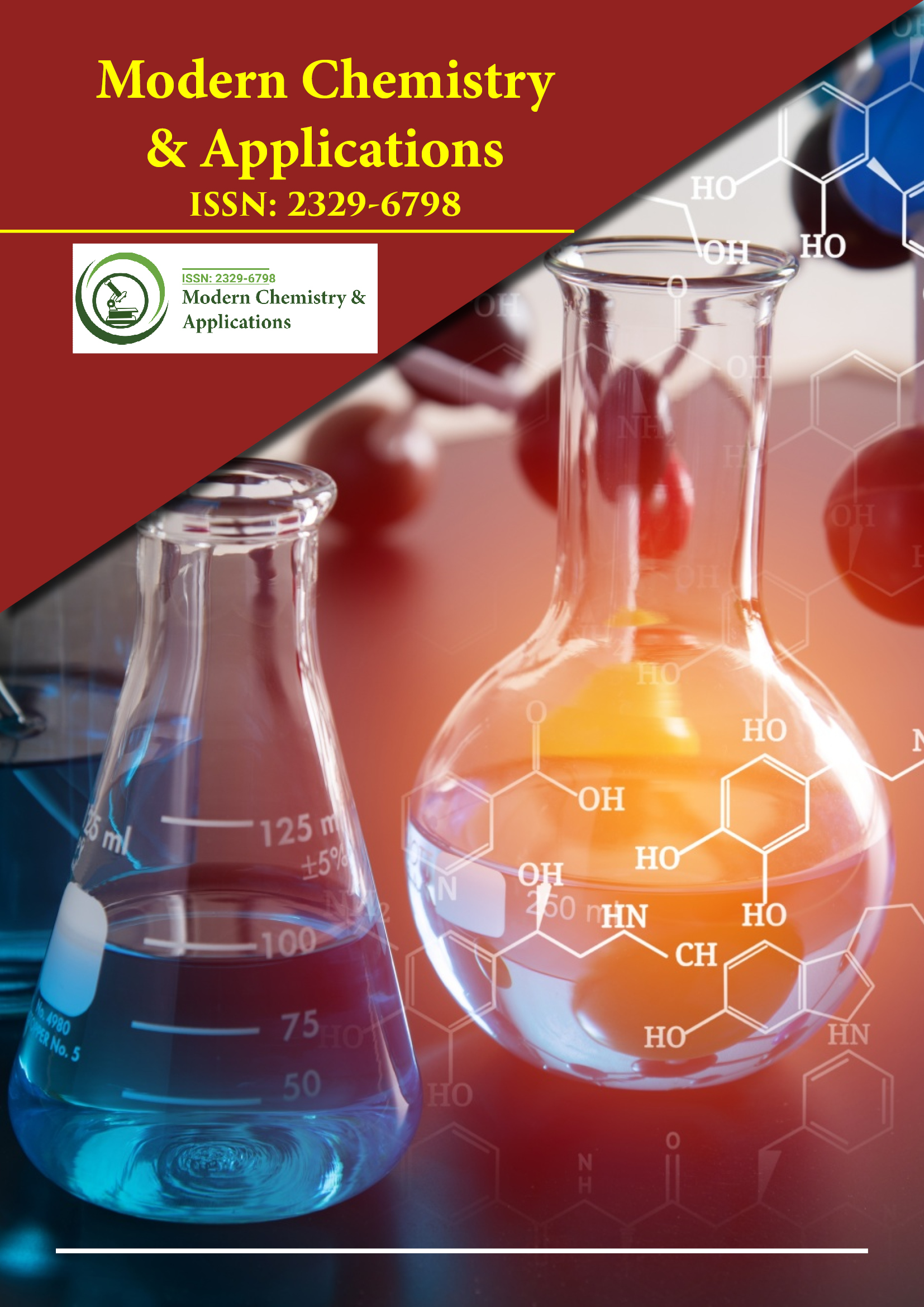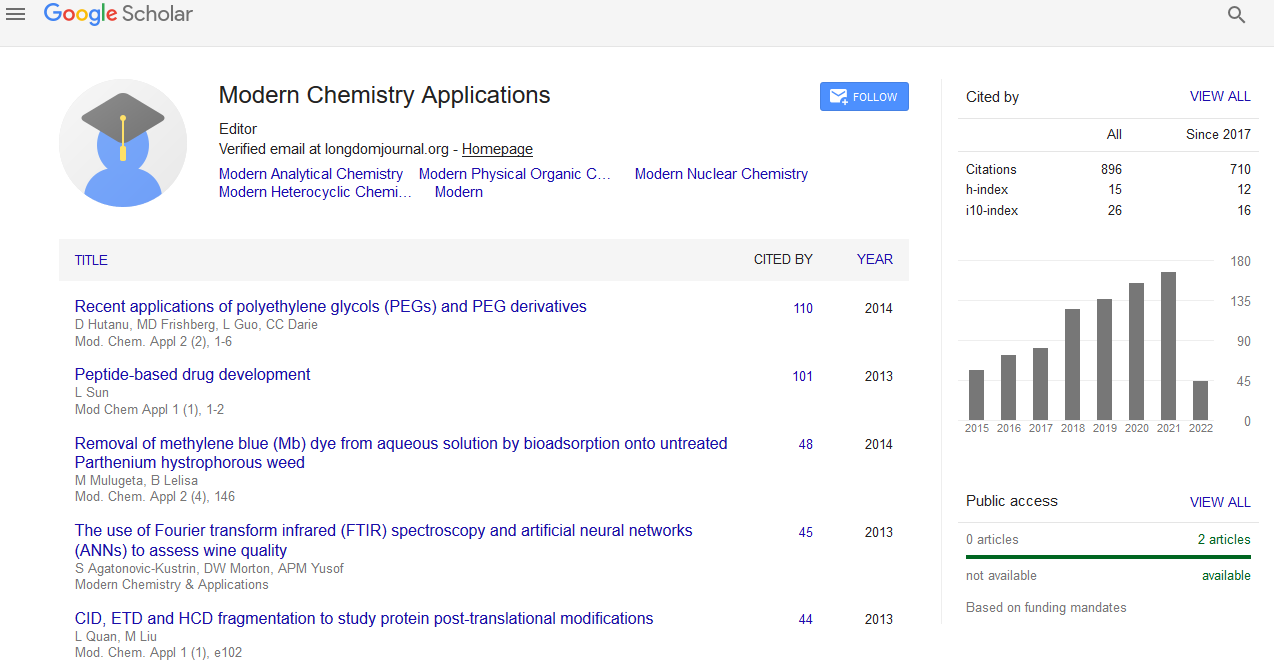Indexed In
- Open J Gate
- JournalTOCs
- RefSeek
- Hamdard University
- EBSCO A-Z
- OCLC- WorldCat
- Scholarsteer
- Publons
- Geneva Foundation for Medical Education and Research
- Google Scholar
Useful Links
Share This Page
Journal Flyer

Open Access Journals
- Agri and Aquaculture
- Biochemistry
- Bioinformatics & Systems Biology
- Business & Management
- Chemistry
- Clinical Sciences
- Engineering
- Food & Nutrition
- General Science
- Genetics & Molecular Biology
- Immunology & Microbiology
- Medical Sciences
- Neuroscience & Psychology
- Nursing & Health Care
- Pharmaceutical Sciences
Commentary - (2025) Volume 13, Issue 1
Recent Advances in Organic and Inorganic Chemistry with Focus on Functional Material Applications
Hiroshi Nakamura*Received: 26-Feb-2025, Manuscript No. MCA-25-29066; Editor assigned: 28-Feb-2025, Pre QC No. MCA-25-29066 (PQ); Reviewed: 14-Mar-2025, QC No. MCA-25-29066; Revised: 21-Mar-2025, Manuscript No. MCA-25-29066 (R); Published: 28-Mar-2025, DOI: 10.35248/2157-7560.25.13.494
Description
Recent developments in both organic and inorganic chemistry have opened up new directions for designing and producing materials with specific characteristics suitable for various advanced technologies. These materials are now widely used in areas including electronics, energy, medicine and environmental science. Innovations in synthetic techniques, analytical methods and theoretical modeling have collectively contributed to significant progress in this area.
In the area of organic chemistry, the development of new reactions has allowed chemists to prepare complex molecules more efficiently and selectively. For example, cross-coupling reactions have been improved to tolerate a broader range of functional groups and operate under milder conditions. These advancements contribute to creating molecules used in lightemitting devices, solar cells and sensors. Molecular design strategies based on π-conjugated systems have been especially important for developing compounds with desirable optical and electronic behavior.
Similarly, inorganic chemistry has experienced substantial advancements, particularly through the design of coordination complexes and metal clusters. These structures often exhibit interesting magnetic, luminescent, or catalytic properties. Metal- Organic Frameworks (MOFs), for instance, are porous materials built from metal ions and organic linkers. They have become popular in gas storage, separation and even drug delivery. The ability to adjust their structural components with precision gives researchers control over their functions, making them highly suitable for such uses.
Hybrid materials, which combine both organic and inorganic components, have emerged as a major focus of research. Perovskite-based solar cells, for example, contain both types of elements and have demonstrated high efficiency in converting sunlight to electricity. Their rapid progress in recent years has made them attractive alternatives to traditional silicon-based devices. However, challenges related to stability and toxicity continue to be areas of intense study.
Another significant area is the development of functional polymers. Polymers with conductive, luminescent, or responsive properties are being designed for use in displays, sensors and wearable devices. These materials respond to stimuli such as temperature, light, or pH and are being incorporated into flexible electronics and biomedical implants. Designing these polymers requires an understanding of both macromolecular architecture and the chemical properties of their monomers.
In addition, supramolecular chemistry has enabled the assembly of complex structures through non-covalent interactions. This method allows for reversible and controllable assembly of components, which can be beneficial in making self-healing materials and drug delivery systems. These materials are structured at the molecular level to perform specific tasks, often involving controlled interactions with biological systems or environmental stimuli.
Analytical tools such as NMR, mass spectrometry and X-ray crystallography have played an essential role in characterizing new compounds and materials. Alongside these, computational chemistry has become a powerful asset in predicting properties and guiding synthesis. The synergy between experimental and theoretical work enhances the reliability and predictability of material performance.
Catalysis continues to be a central focus in both organic and inorganic chemistry. Developing more efficient catalysts, especially those that reduce the need for expensive or rare metals, is a key objective. In particular, photocatalysts and electrocatalysts are gaining attention for their use in water splitting and carbon dioxide reduction, aligning with goals related to sustainable energy.
Environmental concerns have also influenced research directions. The demand for less toxic, more biodegradable materials has led to an increased interest in green chemistry. Researchers are developing synthetic routes that minimize waste and energy consumption, while also exploring alternatives to hazardous reagents. These approaches are being integrated into industrial applications, leading to safer production methods and reduced ecological impact.
Biomedical applications are another area benefiting from these advances. Coordination complexes are being used in imaging and as therapeutic agents, while organic molecules are used to construct drug carriers that release medicine in controlled ways. Surface modification of materials also enables selective interactions with biological systems, improving their performance in medical diagnostics and treatment.
The cooperation between organic and inorganic chemistry continues to enhance the potential of functional materials. Progress in one area often supports development in the other, allowing chemists to explore new directions and refine existing materials for improved performance. As these disciplines evolve, the interaction between them becomes increasingly important in addressing scientific and technological challenges across multiple sectors.
Citation: Nakamura H (2025). Recent Advances in Organic and Inorganic Chemistry with Focus on Functional Material Applications. Modern Chem Appl. 13:494.
Copyright: © 2025 Nakamura H. This is an open access article distributed under the terms of the Creative Commons Attribution License, which permits unrestricted use, distribution and reproduction in any medium, provided the original author and source are credited.


